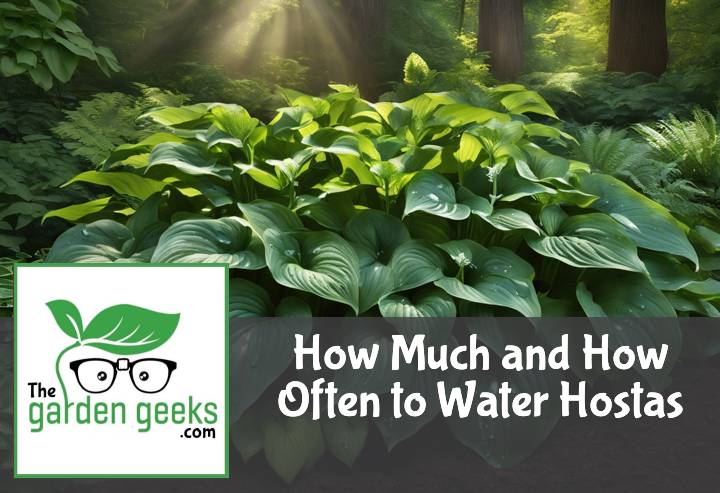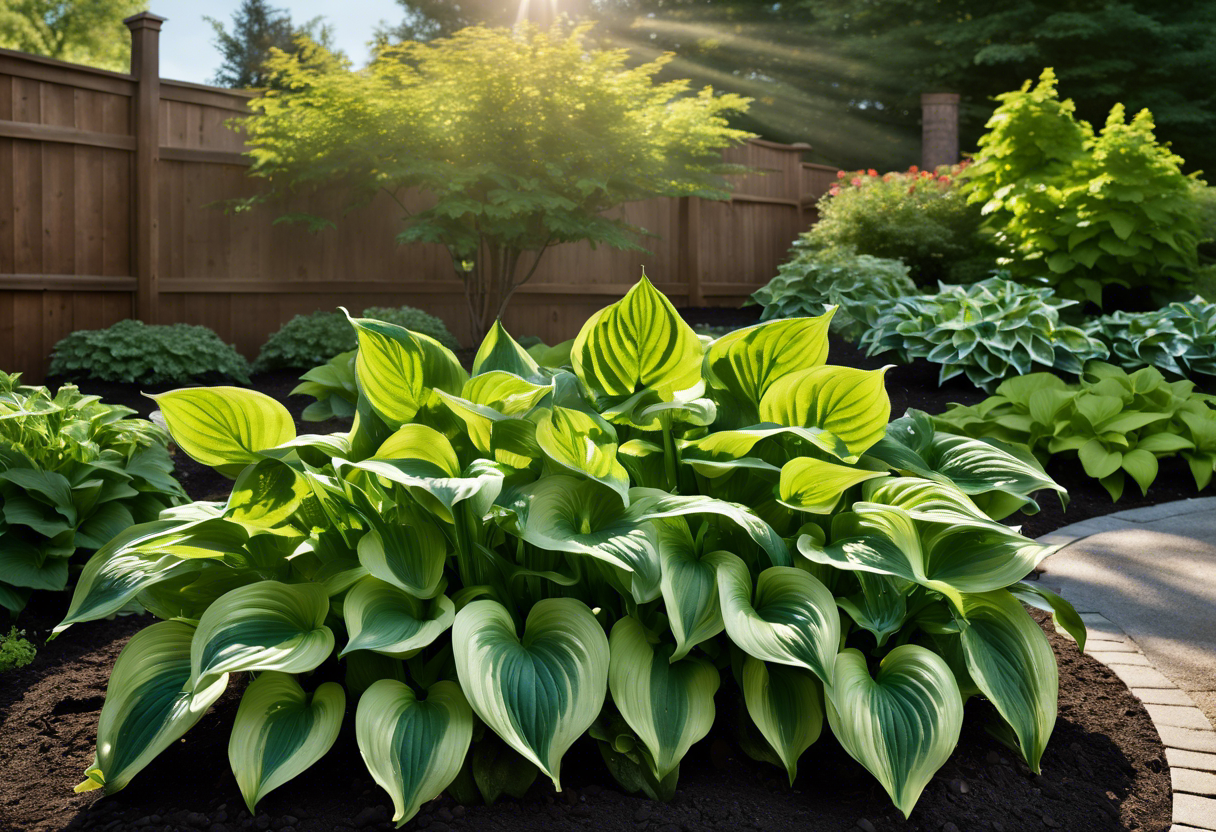Ever found yourself asking, “Just how much and how often to water Hostas?” Well, you’re not alone. Many of us green thumbs have been there – staring at our beloved Hostas, watering can in hand, wondering if we’re about to drown them or leave them parched.
Let’s unravel this mystery together. Keep reading about ‘How Much and How Often to Water Hostas’ as we dive into the world of these leafy beauties. Trust me; it’s going to be a splash!
Key Takeaways
- Hostas need 1 inch of water per week, either from rainfall or manual watering.
- Watering should be done early in the morning to prevent evaporation and fungal diseases.
- Deep watering is recommended to encourage root growth.
- In hot, dry periods, increase watering frequency.
- Overwatering can lead to root rot; ensure soil drains well.
- Mulching can help retain soil moisture and reduce watering needs.
What are Hostas?
Well, let me tell you about hostas plants. These leafy beauties are a gardener’s dream! They’re known for their lush foliage and easy-going nature. Their characteristics make them a big hit among green thumbs everywhere.
Origin and Description of Hostas
Now, where do these fellas come from? The origin of hostas traces back to Asia – Japan, Korea, and China to be exact. They’re quite the travelers, aren’t they? As for their looks, well, they’re real showstoppers. The description of hostas would include broad leaves that can range from bright green to deep blue-green in color. Some even sport white or yellow variegation.
Their growth habits are also worth noting. These guys love the shade but can tolerate some sun too. And guess what? They’re perennials! That means they’ll keep coming back year after year.
Importance of Water for Hostas
Now let’s get down to business – water! It’s like liquid gold for these plants. The importance of water for hosta health cannot be overstated. It helps them grow big and strong and maintain that gorgeous leafy display we all love.
Without enough water, your hosta may start looking a bit sad and droopy – not a good look! So remember folks – when it comes to how much and how often to water hostas, don’t skimp on the H2O!
The effects on development due to watering in hosta plants are pretty significant too. Proper watering ensures healthy growth and reduces the risk of diseases. So keep those watering cans handy!
How Much Water Do Hostas Need?
When it comes to hosta plant care, one thing’s for sure – these leafy beauties love their H2O. But how much is just right? Well, the answer isn’t as straightforward as you might think. The water needs of hostas can vary based on a number of factors. So, let’s dive into the world of watering hostas and figure out what keeps them happily hydrated.
Factors Influencing Water Requirements
First off, climate plays a big role in how much and how often to water hostas. If you’re living in a hot, dry area, your hostas will need more frequent watering than if you’re in a cooler, wetter region.
Next up is soil type. Sandy soils drain quickly and don’t hold onto water well, so if your garden’s got this kind of soil, your hostas might be thirstier than usual. On the other hand, clay soils retain water longer which could mean less frequent watering for your plants.
Finally, the size of your hosta matters too. Larger varieties have bigger root systems that require more water compared to their smaller counterparts. So keep an eye on those big guys!
Signs of Overwatering and Underwatering
Now that we’ve covered the basics of hosta water needs, let’s talk about signs that something might be off with your watering routine.
Overwatered hostas can show symptoms like yellowing leaves or even root rot – yikes! If you notice these signs, it might be time to ease up on the watering can.
On the flip side, underwatered hostas may start wilting or developing brown edges on their leaves. These are clear cries for help from your plant saying “Hey buddy! I’m parched over here!”
Remember folks, maintaining balance is key when it comes to hydrating hostas. Too much or too little water can lead to unhappy plants. So keep an eye out for these signs and adjust your watering routine as needed.
When Should You Water Hostas?
When it comes to how much and how often to water hostas, timing is crucial. The best time to water hostas and the seasonal watering schedule for hostas can significantly impact their health and growth. Let’s delve into these aspects.
Best Time of Day to Water Hostas
Hostas are like us, they love a refreshing drink in the morning. Morning watering for hostas gives them a good start to the day, allowing the moisture to seep into the roots before the sun gets too hot.
In contrast, evening watering can lead to overnight dampness which might invite slugs or other pests. So, if you’re wondering about evening vs morning watering, stick with mornings for your leafy pals.
The optimal daytime for watering hostas also depends on your local climate and weather conditions. If it’s a scorching summer day, an extra splash in the late afternoon wouldn’t hurt either.
Remember, the impact of watering time on hosta health is significant. So keeping up with the best daily schedule for watering hostas is key!
Seasonal Considerations for Watering Hostas
As seasons change, so do the water needs of your hosta plants. In springtime, as new shoots emerge from dormancy, they need consistent moisture. So follow some simple springtime watering tips for hosta plants like regular morning waterings.
Summer brings heat and dry air that could stress your plants out! During this period, you might want to increase your watering frequency depending on how thirsty your plants seem.
Winterizing your hosta plants involves reducing water as they go dormant in colder months. Overwatering during this time could lead to root rot or other issues.
Adjusting water schedule per season for hosta plants isn’t rocket science but requires careful observation of your plant’s needs throughout different seasons. So, keep an eye out and adjust accordingly!
How Often Should You Water Hostas?
When it comes to watering hostas frequency, there’s no one-size-fits-all answer. It depends on a few things, like the age and size of your plant, as well as the weather. But don’t worry, we’ll break down the hosta care basics for you.
Frequency Based on Plant Age and Size
Young hostas are like teenagers, always thirsty! They need more water compared to their mature counterparts. The young hosta water requirements are higher because they’re still growing and establishing their root systems.
As they grow into adulthood, hostas become less needy. The mature hosta hydration needs decrease as these plants become more established. They’ve already got a strong root system in place that can handle a bit of dryness.
But remember, size matters too! Larger varieties will need more water than smaller ones. So keep an eye on your size-based watering for hostas – don’t let those big guys go thirsty!
Adjustments Based on Weather Conditions
Now let’s talk about weather. When it’s hot out there, your hostas will be guzzling water like it’s going out of style. So during summer months or heatwaves, increase your watering hostas in hot weather routine.
Rainy days? Well, Mother Nature is doing some of the work for you! But be careful not to overwater – too much of a good thing can be bad. Keep track of rainfall and adjust your rain impact on watering schedule accordingly.
Some types of hostas are pretty tough cookies though! There are drought-tolerant varieties that can handle drier conditions better than others. If you’ve got these hardy types in your garden, they won’t need as much H2O.
And finally, remember to adjust for seasonal changes. As temperatures drop in the fall and winter, your hostas will need less water. So go ahead and dial back on the watering can during these cooler months.
Techniques for Watering Hostas
When it comes to watering hostas techniques, there are a few different methods you can use. However, the two most effective ones are the deep watering method and the use of soaker hoses or drip irrigation systems. These techniques ensure optimal hosta hydration.
Deep Watering Method
Ever heard of deep watering hostas? It’s a technique that involves soaking the soil deeply to reach the roots. This method encourages deeper root growth, which is beneficial for your hostas’ overall health.
The benefits of deep watering are numerous. For one, it helps prevent surface evaporation, ensuring that your precious water doesn’t just vanish into thin air! Plus, it promotes healthier and stronger plants.
So how do you go about implementing this deep watering technique? Well, it’s pretty simple really. You just need to water your hostas thoroughly until the water penetrates several inches into the soil. Remember, we’re aiming for effective hydration for hostas, not a quick sprinkle!
Use of Soaker Hoses or Drip Irrigation Systems
If you’re looking for an efficient way to water your hostas without having to stand around with a hose in hand, then consider using soaker hoses or drip irrigation systems. These tools can be real game-changers when it comes to hydrating your green buddies.
Soaker hoses for hostas work by slowly seeping water directly into the soil at root level. They’re great because they deliver moisture right where it’s needed most – at the roots!
On the other hand, drip irrigation systems usage involves delivering water drop by drop directly to the plant’s base. It’s an incredibly efficient method that reduces water waste and ensures each plant gets exactly what it needs.
Whether you choose soaker hoses or drip systems, both options offer an efficient watering solution. So, give them a try and see how your hostas thrive!
Common Mistakes in Watering Hostas
When it comes to watering hostas, mistakes are often made. It’s a delicate balance, you know? Too much or too little water can lead to some serious hosta plant care issues.
Overwatering and Its Consequences
Overwatering is one common mistake that can have dire consequences for your hostas. When you give ’em too much H2O, the signs of overwatered hosta plants start to show up. Leaves turn yellow, wilt, and may even fall off completely! The roots can also rot from all that excess moisture, causing irreversible damage to your beloved green buddies.
The effects of too much water on hostas aren’t pretty either. It’s like drowning them in kindness – literally! Your well-intentioned watering can lead to a weakened plant more susceptible to diseases and pests. So remember folks, when it comes to watering hostas, less can sometimes be more!
Inadequate Watering and Its Impact
On the flip side, not giving your hostas enough water is just as bad. Under-watered hosta symptoms include drooping leaves and stunted growth – they’re literally thirsting for hydration! Long-term neglect can lead to a weak plant that’s more prone to disease and pests.
The impact of inadequate watering is significant. Without enough water, your hostas might not survive those hot summer months. They’ll struggle to grow and bloom without adequate hydration – it’s like trying to run a marathon without drinking any water! So remember folks, when figuring out how much and how often to water hostas, strike a happy medium between drenching and desert conditions!
To Wrap Up
Just like a toddler needs the right amount of milk and naps, your hostas need the perfect balance of water and rest to thrive. We’ve learned that it’s not just about watering them willy-nilly, but understanding How Much and How Often to Water Hostas.
So, put on your gardening gloves, grab that watering can, and let’s give our leafy friends the TLC they deserve! Remember, a happy hosta is a well-watered hosta!





